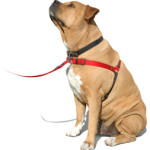For your dog’s health and safety and your walking enjoyment, choose appropriate equipment for your dog. Your best bets for safe walking equipment are harnesses, head halters, or martingale collars, and these must be properly fitted. Here are some pros and cons of each of these pieces of equipment.
Back-Clip Harnesses (Puppia, AKC, and many, many others)

Back-clip harnesses are a popular tool in New York City. They move the pressure away from the dog’s neck and trachea, and move it to the dog’s chest, which is much stronger and less likely to be damaged from a lifetime of pulling against a leash. Unfortunately, they do allow dogs to pull harder against the leash because of the strength of their chests and their center of gravity. Just consider how sled dogs, who train to pull heavy weight for long periods of time, are attached to their load. They aren’t asked to pull with their necks, but with their chests.
Back-clip harnesses must be properly fitted to prevent dogs from slipping out. A general rule is two (human) fingers should be able to be slipped between the dog and the harness at any given spot. Back-clip harnesses are a safe tool for dogs who are trained to walk nicely on a leash, are at little risk for bolting from their owners, and for owners who can hang on as tightly as they need to keep their dog from getting away.
Front-Clip Harnesses (Easy-Walk, Sense-ation)

Front-clip harnesses fit around a dog’s body and the leash attaches to a ring on the dog’s chest. This makes it so the dog cannot pull from the strongest part of his body, but rather is pulling more from his front arm pits. This is less comfortable for the dog, and it also weakens his ability to pull. Front-clip harnesses protect your dog’s neck and trachea.
Front-clip harnesses need to be properly fitted to prevent a dog from slipping out and also to keep the dog from pulling hard against the harness. Two fingers should be able to be slipped between the dog and the harness at any given spot. Many front-clip harnesses need to be continually sized as the buckles slip with use.
Head Halters (Gentle Leader, Halti)

Head halters move the site of your dog’s pulling away from chest, neck, trachea, or armpits to his head. This is the weakest possible place for your dog to pull from. Also, head halters give you control of your dog’s muzzle, or the “pointy end” of your dog. As the owner of a leash-reactive dog, using a head halter makes me comfortable taking her out in public. I also use a head halter on my tiny dog who is highly squirrel-motivated and pulls surprisingly hard for an 8-pound dog.
Head halters allow for very nuanced communication with your dog regarding loose-leash walking, turning signals, slowing down and speeding up. Head halters give you more control over your dog’s mouth, which is an excellent benefit for dogs who regularly “vacuum” the street for chicken bones.
You should never use a retractable leash with a head halter, and don’t jerk the leash when your dog is wearing a head halter.
One unfortunate side effect to having your dog in a head halter is that people who are not “in the know” will assume it’s a muzzle. I’ve had to thicken my skin to comments of passers-by who say stuff like, “That dog’s mean, he’s wearing a muzzle.” Alas, the benefits of the head halter for me and my dog far outweigh my need for compliments on my dog.
Martingale Collars

Martingale collars look like flat collars with a couple extra loops. They are also called “no-slip” collars. When properly fitted, they ensure a dog cannot slip out of his collar, even by pulling backward. Proper fit means that when pulled completely tight, the collar is closed to exactly the size of the dog’s neck. Martingale collars can look loose when not being pulled tight; in fact, they slip on and off the dog with no buckles. To test for proper fit, pull the two side rings together–they should come within about an inch of each other around your dog’s neck and no closer.
Be Wary of Equipment that Promises a Miracle
There are a lot of pieces of equipment on the market that promise miracle results, but can have unintended side effects.
Retractable leashes allow your dog to march up to other dog’s faces–dangerous for you and your neighbors.
Prong and shock collars to punish pulling can have the unintended side effect of causing your dog to associate the excitement of seeing another dog with pain or choking. You might want to stop the pulling, but your dog associates the pain or choking with seeing other dogs, and this can cause aggression where there wasn’t any. If you encounter a dog with a prong or shock collar, be wary of getting too close with your dog. These pieces of equipment are so dangerous that some governments, including that of New Zealand, parts of Australia, and most recently, Quebec, are banning them altogether.
Finally, one word of warning on using regular flat collars attached to a leash. Flat collars can be slipped out of backwards if a dog tries to flee a situation. Several of the recent dog losses in and near Harlem were due to anxious dogs slipping their collars and running away from something scary.